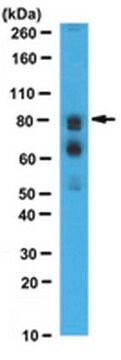推薦產品
生物源
rabbit
品質等級
抗體表格
affinity isolated antibody
抗體產品種類
primary antibodies
無性繁殖
polyclonal
物種活性
human
技術
ChIP: suitable
immunoprecipitation (IP): suitable
western blot: suitable
NCBI登錄號
UniProt登錄號
運輸包裝
wet ice
目標翻譯後修改
unmodified
基因資訊
human ... WAC(51322)
一般說明
WAC (WW domain-containing adapter protein with coiled-coil) functions as a linker between gene transcription and histone H2B monoubiquitination at ′Lys-120′ (H2BK120ub1). Wac interacts with the RNA polymerase II transcriptional machinery through its WW domain and with RNF20-RNF40 via its coiled-coil region. It has been shown to regulate H2BK120ub1, gene transcription, cell-cycle checkpoint activation in response to DNA damage, positively regulate amino acid starvation-induced autophagy and negatively regulate the ubiquitin proteasome pathway. In nuclear speckles it has been observed to colocalize with pre-mRNA processing complexes. This antibody recognizes the C-terminus of the WAC protein.
免疫原
Recombinant protein corresponding to human WAC.
應用
Anti-WAC, C-terminus detects levels of WAC proteins & has been published & validated for use in wb, IP & ChIP.
Research Category
Epigenetics & Nuclear Function
Epigenetics & Nuclear Function
Research Sub Category
Chromatin Biology
Chromatin Biology
Western Blotting Analysis: 1 µg/mL of this antibody from a representative lot detected WAC, C-terminus in 10 µg of HEK293 cell lysate.
Immunoprecipitation Analysis: A representative lot from an independent laboratory detected WAC, N-terminus in 293T cell lysates stably transfected with SFB-RNF20 and in HCT116 cell lysates transfected with siRNA negative control (Zhang, F. and Yu, X. (2011). Mol Cell. 41(4):384-397.).
Chromatin Immunoprecipitation: A representative lot from an independent laboratory detected WAC, N-terminus in HCT116 cell lysates transfected with siRNA negative control, but demonstrated a loss of signal in HCT166 cell lysates transfected with siRNF20 (Zhang, F. and Yu, X. (2011). Mol Cell. 41(4):384-397.).
Westerm Blotting Analysis: A representative lot from an independent laboratory detected WAC in 293T cell lysates transfected with siRNA negative control, but demonstrated a loss of signal in 293T cell lysates transfected with siWAC (Zhang, F. and Yu, X. (2011). Mol Cell. 41(4):384-397.).
Immunoprecipitation Analysis: A representative lot from an independent laboratory detected WAC, N-terminus in 293T cell lysates stably transfected with SFB-RNF20 and in HCT116 cell lysates transfected with siRNA negative control (Zhang, F. and Yu, X. (2011). Mol Cell. 41(4):384-397.).
Chromatin Immunoprecipitation: A representative lot from an independent laboratory detected WAC, N-terminus in HCT116 cell lysates transfected with siRNA negative control, but demonstrated a loss of signal in HCT166 cell lysates transfected with siRNF20 (Zhang, F. and Yu, X. (2011). Mol Cell. 41(4):384-397.).
Westerm Blotting Analysis: A representative lot from an independent laboratory detected WAC in 293T cell lysates transfected with siRNA negative control, but demonstrated a loss of signal in 293T cell lysates transfected with siWAC (Zhang, F. and Yu, X. (2011). Mol Cell. 41(4):384-397.).
品質
Evaluated by Western Blotting in K562 cell lysate.
Western Blotting Analysis: 1 µg/mL of this antibody detected WAC, C-terminus in 10 µg of K562 cell lysate.
Western Blotting Analysis: 1 µg/mL of this antibody detected WAC, C-terminus in 10 µg of K562 cell lysate.
標靶描述
~80 kDa observed. An uncharacterized band may be observed at ~95 kDa and ~120 kDa in some cell lysates.
外觀
Affinity purified
Format: Purified
Purified rabbit polyclonal in buffer containing 0.1 M Tris-Glycine (pH 7.4), 150 mM NaCl with 0.05% sodium azide.
儲存和穩定性
Stable for 1 year at 2-8°C from date of receipt.
分析報告
Control
K562 cell lysate
K562 cell lysate
其他說明
Concentration: Please refer to the Certificate of Analysis for the lot-specific concentration.
免責聲明
Unless otherwise stated in our catalog or other company documentation accompanying the product(s), our products are intended for research use only and are not to be used for any other purpose, which includes but is not limited to, unauthorized commercial uses, in vitro diagnostic uses, ex vivo or in vivo therapeutic uses or any type of consumption or application to humans or animals.
未找到適合的產品?
試用我們的產品選擇工具.
儲存類別代碼
12 - Non Combustible Liquids
水污染物質分類(WGK)
WGK 1
閃點(°F)
Not applicable
閃點(°C)
Not applicable
分析證明 (COA)
輸入產品批次/批號來搜索 分析證明 (COA)。在產品’s標籤上找到批次和批號,寫有 ‘Lot’或‘Batch’.。
Feng Zhang et al.
Molecular cell, 41(4), 384-397 (2011-02-19)
Histone H2B ubiquitination plays an important role in regulating chromatin organization during gene transcription. It has been shown that RNF20/40 regulates H2B ubiquitination. Here, using protein affinity purification, we have identified WAC as a functional partner of RNF20/40. Depletion of
Danni Meng et al.
Oncology letters, 21(6), 436-436 (2021-04-20)
p53 is one of the most important tumor suppressor genes, and its primary function is to act as a transcriptional activator to control cell cycle arrest, DNA repair and cellular metabolism by recognizing and binding to specific DNA sequences. Defects
我們的科學家團隊在所有研究領域都有豐富的經驗,包括生命科學、材料科學、化學合成、色譜、分析等.
聯絡技術服務